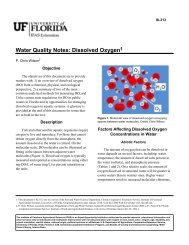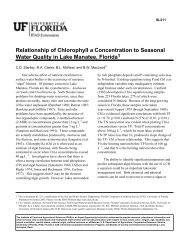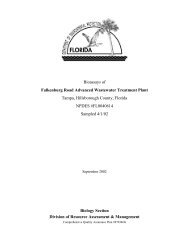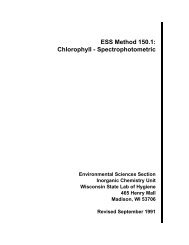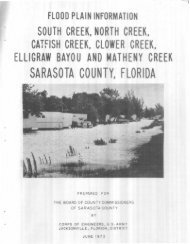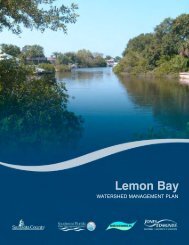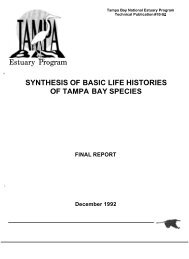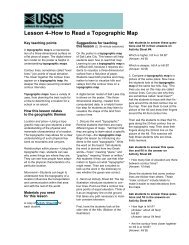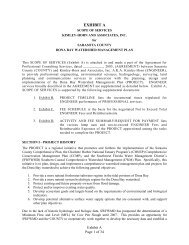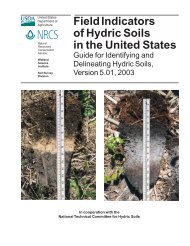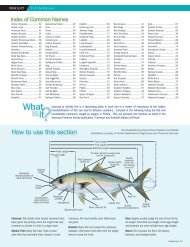CLIENT NAME - Sarasota.WaterAtlas.org
CLIENT NAME - Sarasota.WaterAtlas.org
CLIENT NAME - Sarasota.WaterAtlas.org
You also want an ePaper? Increase the reach of your titles
YUMPU automatically turns print PDFs into web optimized ePapers that Google loves.
2.3.1.1.7 Chemical Feed SystemsFigure 2.5 illustrated the chemical feed points at the Carlton WTF. Chemicals shown in boldare those used regularly. The following describes the chemical feed strategies currentlyemployed at the Carlton WTF:• Hydrochloric acid - pH adjustment for degasification.• Sodium hydroxide - pH adjustment for desired finished water pH.• AF-600 - EDR membrane anti-scalant.• Orthophosphate - corrosion inhibition. The County is considering switching thecorrosion inhibitor to an orthophosphate/polyphosphate blend in the near future.• Chlorine - disinfection. The Carlton WTF was converted from gaseous chlorine toliquid sodium hypochlorite in 2003. Liquid chlorine is added to the chlorine contactchambers where contact time to meet primary disinfection requirements occurs.• Ammonia - Ammonia is added to the end of the chlorine contact chambers for theformation of chloramines for residual disinfection. The typical chlorine to ammoniaratio target is approximately 4.8 to 1. The target finished water chloramine residualconcentration is 4 mg/L.The chemical storage area is located in the center of the WTF site with the bulk storagetanks stored outdoors and the day tanks and chemical feed pumps stored in individualinterior rooms. The bulk storage tank containment areas were coated approximately sixyears ago, and the coating is still in relatively good condition. However, the corrosioninhibitor containment area that was installed approximately 2 years ago was not coated andis now experiencing some corrosion. Facility staff stated that they will coat this containmentarea soon. Chemical storage tank information is presented in Table 2.2. It should be notedthat due to its low use, the AF-600 anti-scalant is bought in 55-gallon drums and is pumpedinto the day tank.Chemicals are fed in a manual mode, usually based on the number of EDR units inoperation. Although there is the capability to flow pace some of the chemicals, facility staffprefer to operate the chemical feed pumps manually. They stated that the varying flow fromthe EDR units (due to the flushing cycle after polarity reversal) makes it difficult to useautomatic equipment that operates best in constant flow conditions. Facility staff has beenunsuccessful in flow pacing chemicals downstream of the EDR units; however, some of thepretreatment chemicals have been flow paced successfully in the past since they are basedon relatively constant influent flows.FINAL - August 31, 2005 16H:\Client\SAR Co_SAR\6873C00 WATER SUPPLY MASTER PLAN UPDATE\Deliverables\TM 2 - Water System Assets\Final\TM2 Final.doc



